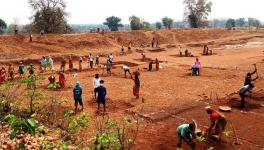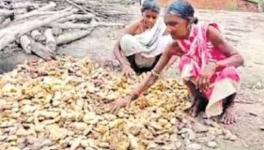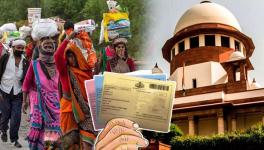Instead of Strengthening Infra for Food Security, Govt. Moves in Opposite Direction
Representational use only.
It has been over a year since the COVID-19 pandemic hit India and a jarring lockdown was announced by Prime Minister Modi on March 24, 2020. The sudden announcement led to an en-masse migration of workers from the cities back to their villages. By and large the migrant workers in the cities led a hand-to-mouth existence. Therefore, a complete shutdown rendered their survival impossible.
In a country home to a large proportion of the world’s hungry (India has been ranked 94th among 107 countries in the Global Hunger Index 2020), legitimate concerns were raised about how the administration had planned to take care of the food requirements of the urban and rural poor, as they stared at an indefinite lockdown. The situation was worsened as a result of non-payment of dues, loss of jobs and an abrupt shutdown of the economy.
Prominent economists and policy makers from different shades of the political spectrum were broadly in consensus in advocating some sort of a universalisation of the Public Distribution System, even if temporary, to provide for the immediate ration requirements of the poor during a time of distress. In April 2020, famed economists like Amartya Sen, Raghuram Rajan and Abhijit Banerjee argued for the need to issue temporary ration cards to everyone who wanted to be able to collect monthly allocations for a minimum period of six months.
To tackle the situation, the government launched a campaign for the distribution of food grains in addition to food distribution under the National Food Security Act (NFSA). In March 2020, the government launced the Prime Minister Garib Kalyana Anna Yojana (PMGKAY). Under this scheme, around 80 crore NFSA beneficiaries from all states and union territories were entitled to receive five kgs of food grains per month and one kg of pulses per family per month for the period between April and June. Later, the scheme was extended for five more months until November 2020.
In May 2020, the government launched the Atma Nirbhar Bharat Scheme (ANB) as part of the Atma Nirbhar Bharat Package. Under this scheme, a total of eight lakh million tonnes (LMT) of food grains were to be distributed to around eight crore migrant labourers across the country (as estimated at the time of the launch). In addition, the government also approved a supply of food grains for non-NFSA beneficiaries who had state ration cards for distribution between April and June 2020 at the rate of Rs 21 per kg for wheat and Rs 22 per kg for rice. The total allocation and offtake of food grains on this was 9.65 LMT.
The Secretary of the Department of Food and Public Distribution, Sudhanshu Pandey, argued that the country’s PDS had swiftly come to the fore by scaling up to distribute almost double the quantity of food grains to more than 80 crore beneficiaries from April to November 2020. “Nowhere in the world, a PDS as big as in India is being run,” he emphasised.
While it is true that the public infrastructure in place under the PDS and NFSA had come to the rescue in this situation of dire need, it should be noted that the stocks of food grains distributed during the pandemic constituted a small proportion of the stocks available for distribution in the central pool. The following tables give a sense of the total allocation, offtake and distribution of food grains under different schemes between April and November 2020.
Table 1
Source: Foodgrain Bulletin
Table 2
*Allocation, offtake under PMGKAY is during April-November, 2020
**Allocation, offtake under ANB (Atma Nirbhar Bharat) is during May-June, 2020
Sources: https://dfpd.gov.in/writereaddata/Portal/Magazine/FoodgrainBulletinforFebruary2021.pdf
Except for the month of May, the total stocks in the central pool exceeded the buffer stock norms by at least two times between April and November last year. Yet, the distribution of food grains has been less than 25% of the total stocks available for distribution, except in May, when it was 33%. Despite overflowing stocks of food grains in the Food Corporation of India's (FCI) godowns and state agencies, the stocks were not opened up for distribution to the people of the country. This, despite the fact that the proponents of the neoliberal model of development have been incessantly complaining about the overflowing stocks with the government calling it a ‘problem of plenty.’ Their answer to the problem is not expanding the PDS to cover more people in need. Instead, they advise the government to reduce procurement from farmers at assured prices (Minimum Support Price).
Probing the number of beneficiaries revealed that over the given period, a total of 24.72 LMT of food grains had been distributed to 5,48,08,120 migrants under ANB. It means that on an average, each person got an average of 2.5 kgs per month as opposed to the promised five kgs per month. At the same time, the data on distribution under PMGKAY, as revealed in an answer to a Rajya Sabha, revealed a decline in the number of beneficiaries over successive months, as shown in Table 3. Data on beneficiaries is only available till the month of September, 2020. While the scheme envisaged a distribution of five kgs of food grains (either wheat or rice) per person per month to a total of 80 crore beneficiaries, data shows that the number of beneficiaries and grain distributed had reduced to 16.72 crores and 8.36 LMT by the month of September.
Table 3
In addition to inadequate distribution, the process has been marred by exclusion of a large proportion of vulnerable population from the ambit of the Targeted PDS. Currently, the NFSA provides for an estimated 80 crore beneficiaries, covered as Priority Households or Antyodaya Anna Yojana (AAY) ration cards. However, this coverage is based on the population estimates from Census 2011 and excludes close to 9.5 crore eligible beneficiaries from its ambit. In February 2020, while recommending that the national rural-urban coverage ratio under NFSA be reduced from 70-50 to 60-40, the government think-tank NITI Aayog, in a discussion paper, reportedly argued that updating the population level from Census 2011 to the present level will expand the total coverage of beneficiaries under NFSA from the existing 81.35 crore to 89.52 crore.
Among the excluded were also NFSA beneficiaries who do not have their cards seeded with Aadhaar cards. According to the National Food Security Portal – as on April 7, 2021 – from a total of 79.26 crore beneficiaries, 70.54 crore beneficiaries were sededed with their Aadhaar cards. This leaves a gap of 8.72 crore beneficiaries who do not have their NFSA cards seeded with their Aadhaar cards till date. Further, data from March 2021 from the portal suggests that since June last year a total of 2.89 lakh AAY cards have been added while 3.79 lakh cards have been deleted. This means that there has been a net reduction in the number of AAY beneficiaries since June 2020 by about 90,000 cards. More recently, in March 2021, a plea was filed in the Supreme Court challenging the cancellation of three crore ration cards by the central government for not linking with Aadhaar cards.
At the same time, the amendment to the Essential Commodities Act, a part of the package of three Farm Laws, has removed the existing limits on stocks and storage of ‘essential commodities’ such as cereals, pulses, oilseeds, edible oils, oilseeds, onions and potatoes. The passage of three laws by the government in September 2020 have already raised fears that the public procurement and public distribution system in India is under attack. As the country starts coming under the grip of a second wave of the COVID-19 pandemic, instead of strengthening the public infrastructure to ensure food security to the poor, the government is moving in the opposite direction and even dismantling an existing structure that may have helped them stay afloat.
The writer is an author and a Research Associate with Newsclick. The views are personal. She can be reached on Twitter @ShinzaniJain.
Get the latest reports & analysis with people's perspective on Protests, movements & deep analytical videos, discussions of the current affairs in your Telegram app. Subscribe to NewsClick's Telegram channel & get Real-Time updates on stories, as they get published on our website.
























